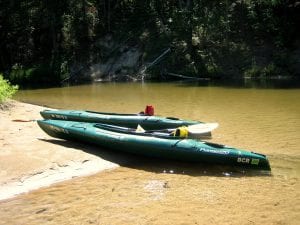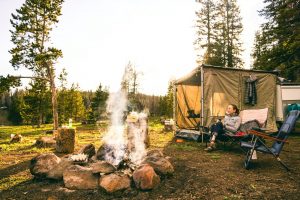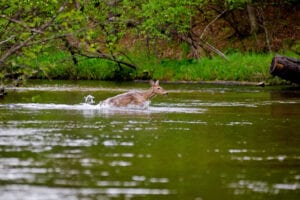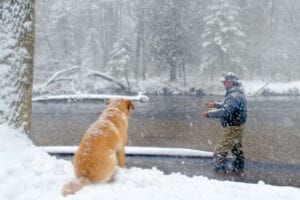Photo by Todd & Brad Reed Photography
The Pere Marquette River flows westerly from Lake County, through the communities of Baldwin, Branch, Walhalla, Custer, Scottville, and Ludington. The river drains into Pere Marquette Lake and eventually Lake Michigan. The PM River is not deep, averaging two to four feet deep and about 30-40 feet wide.
The Pere Marquette Loop makes for a nice short trip. It starts at Old US-31 in Ludington and circles near the State Road Bridge. From there to Scottville Riverside Park, the river becomes wider with no landings, making for a long trip. Custer Park and Indian Bridge are two landing spots within the section between Scottville and Walhalla, where the river is wide and deep. Starting in Walhalla, there are three major sections: Walhalla to the Upper Branch Bridge; Upper Branch to Bowman’s Bridge and Bowman’s Bridge to the M-37 Bridge in Baldwin.
The PM River is an extremely popular fishing location, due to the abundance of rainbow trout. Steelhead are also very prominent, as well as various species of frogs, crayfish, snakes, and turtles. Within the Manistee-Huron National Forest that surrounds the Pere Marquette River, there’s an abundance of wildlife including deer, wild turkey and small game.
The current of the Pere Marquette River is steady and considerably clear, which makes it perfect for paddlers with basic skills. Depending what section you decide to canoe or kayak, your trip can take you anywhere from a few hours to a few days. There are numerous canoe liveries along the river, and over 2,000 private campsites dispersed throughout the watershed.
Locally, you can enter the Pere Marquette River from old Pere Marquette Highway, just south of Ludington…Scottville Riverside Park…Indian Bridge on Reek Road southeast of Custer and Walhalla Road Bridge south of Walhalla.
Whatever your preference- sport fishing, a relaxing canoe trip, or camping in the forest, the Pere Marquette River and surrounding area is the perfect spot for your next vacation or day trip.
The Pere Marquette Loop makes for a nice short trip. It starts at Old US-31 in Ludington and circles near the State Road Bridge. From there to Scottville Riverside Park, the river becomes wider with no landings, making for a long trip. Custer Park and Indian Bridge are two landing spots within the section between Scottville and Walhalla, where the river is wide and deep. Starting in Walhalla, there are three major sections: Walhalla to the Upper Branch Bridge; Upper Branch to Bowman’s Bridge and Bowman’s Bridge to the M-37 Bridge in Baldwin.
The communities along the Pere Marquette River host many unique events throughout the year. In Baldwin, one of the most popular events is the annual Troutarama which includes rides, a beer tent, live music, food booths, and more. The event spans over four days in July. Pere Marquette Expeditions hosts the popular Monster Pike Fishing Tournament each February. This tourney is only for pike and awards a 1st, 2nd, and 3rd place winner. Scottville’s Riverside Park on Pere Marquette River hosts the West Michigan Old Engine Club Shows which are held periodically from May-October.
The Ludington & Scottville Area Chamber of Commerce
119 S. Rath Ave., Ludington, MI, 49431
Planning a visit to the Pere Marquette River area? Have questions about your trip? Here’s where you can find help:

Pere Marquette River, with it’s moderately fast current and clear water, is an extremely popular river for canoeists and kayakers.

The Pere Marquette River is extremely popular with canoeists and fishermen. Many camping options are available along the river.

The Pere Marquette River area is rich with wildlife, offering great outdoors hunting and fishing opportunities.

All year long, there are activities going on in the Scottville area to keep everyone happy. No matter what the season, there’s always plenty of great events to keep you coming back. Boredom is never a problem here!

The Pere Marquette River area is rich with wildlife, offering great outdoors hunting and fishing opportunities.

The spring/fall runs of steelhead and salmon, the resident brown trout and “brookies” make the PM River extremely popular for fishing.